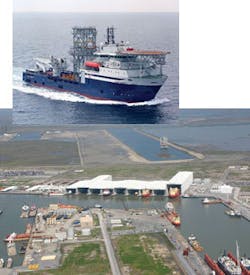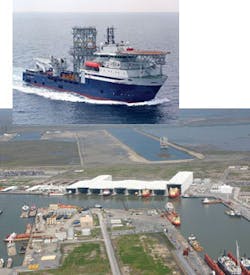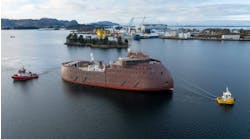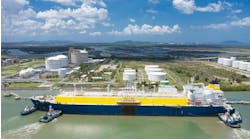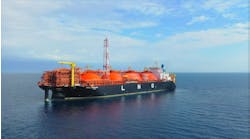David Paganie, Senior Editor
The Chouest family of companies, the largest tenant at Port Fourchon, was founded in Galliano, La., in 1960.
Chouest’s portfolio of services offered from Port Fourchon includes logistics support, staging and storage, tank cleaning, vessel repair, and riser inspection and repair.
The company’s primary services are launch- ed from its C-Port, C-Port 2, Martin Terminal, and North American Shipbuilding-Fourchon facilities. With these capabilities, Chouest at Port Fourchon can market itself as a ‘one-stop shop, designed to reduce vessel turnaround time.
The Chouest companies currently service many of the major deepwater projects in the Gulf, including some 52 rigs.
Slip concept
The Chouest-owned C-Port terminals comprise 18 covered slips, 37 overhead cranes, 25-ft drafts, complete dockside services, and 24-hour access. One of the slips is equipped with a 200-ton overhead crane, specifically for heavy-lift operations. Other services performed within this slip include testing of subsea trees before loadout, and handling of suction piles and synthetics.
“These services are performed portside ready for loading directly onto an anchor handling vessel, which reduces boat-time, manhours and overall turnaround time,” says Gary Chouest, president of Chouest.
According to Chouest, C-Port was actually conceptualized in response to draft limitations experienced by the company while supporting Shell’s Auger project out of a Morgan City facility. Concurrently, it was also building larger vessels that carried up to three times more cargo than its predecessors. As a result, Chouest decided to build a port equipped with facilities to reduce turnaround time.
“The C-Port’s slip concept was derived from a proposal issued to Shell to minimize bulkhead costs,” says Chouest. “With the slip concept, you only need to load a vessel on the aft deck. In addition, the slips are fitted with crawler cranes on the finger piers between the slips, which allow for cross-tying between bulk heads to reduce costs.”
After approval from Shell, Chouest proceeded with construction of the port’s 18 covered slips at Fourchon, each designed with 25,000 sq ft of staging area.
C-Port 2 on the E-Slip in Port Fourchon. (Inset) Island Frontier is the first subsea well intervention vessel delivered in the Island Offshore joint venture.
Another key component of the slips is that they contain fuel storage in elevated compartments above an incoming vessel, says Roger White, Chouest senior VP. “Due to the fuel’s elevated position, nothing can fall on the vessel’s fuel line, which could cause a rupture and disrupt turnaround efficiency,” says White. “As a result, we are the only facility in Fourchon that can legally load and unload deck cargo while fueling the vessel.”
Meanwhile, “our one-stop shop facility has reduced loading and unloading time in port from an average of two-and-a-half days to less than 18 hours, resulting in significant cost savings to the customer,” says White. This is accomplished through implementation of Chouest’s C-Logistics operation.
Supply chain management
The name C-Logistics means integrated supply chain management for drilling, production, and construction projects in shelf and deepwater locations in the Gulf, Chouest says.
At the outset of C-Logistics implementation, key performance indicators are fed into the company’s proprietary software to produce the most cost-effective vessel profile and allot deck space, schedule and monitor terminal delivery, staging and loading, identify shipping corridors and define optimum routes, and arrange for dockside support services as required.
“In fact, Shell Oil Co. approached Chouest in the program’s early days, and realized a savings of $20 million after their first year using the service,” says White.
Another advantage for companies consolidating services and establishing a primary logistics base at Port Fourchon is incorporation of C-Logistics’ vessel-sharing agreement, White says.
“The trend now seems to be moving toward sharing of assets,” said White. “Oil companies can get together and sign a single agreement to share vessels and terminals, which results in significant cost savings to the customer.”
“On average, oil companies have realized about a 20% savings in overall logistics costs,” adds Chouest.
Chouest says that it plans to offer this supply chain management model in other regions of the world, including Brazil and West Africa.
Subsea intervention
Chouest is delving into the international subsea intervention business with its established joint venture company, Island Offshore Shipholding LP, owned by the Chouest and Ulstein families.
The JV company was created to save customers money through a combined subsea well intervention and construction service with a single vessel. Island launched its first of 13 planned subsea well intervention vessels,Island Frontier,in 2004 to perform this service.
The 348-ft by 78-ft by 28-ft subsea support and light well intervention vessel is equipped with DP3 capabilities, two ROVs, pipe and cable-laying capabilities, two cranes, and accommodations for 84 people. More recently, the company says it was awarded a six-year contract with Statoil, providing the sufficient financial support to build a new well intervention vessel.
In addition, the company announced plans to build several more vessels including three anchor-handling towing supply (AHTS) vessels based on a propriety hull design. The vessels will be built at Chouest’s North American Shipbuilding facility in Larose, La., with delivery expected in the first and third quarter of 2007, and in the second quarter of 2008. Chouest holds an option for delivery of three additional AHTS vessels.•
